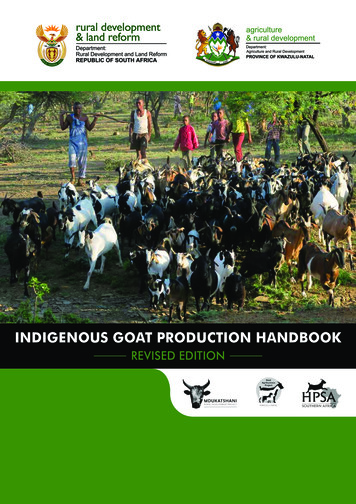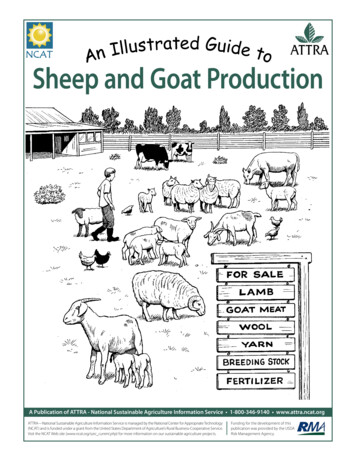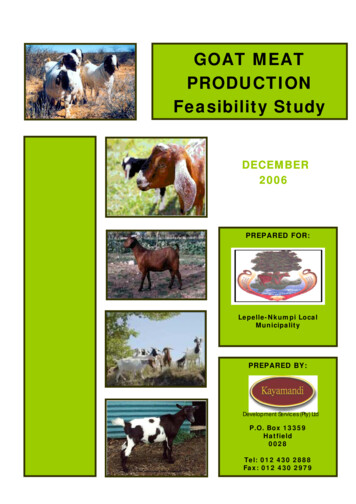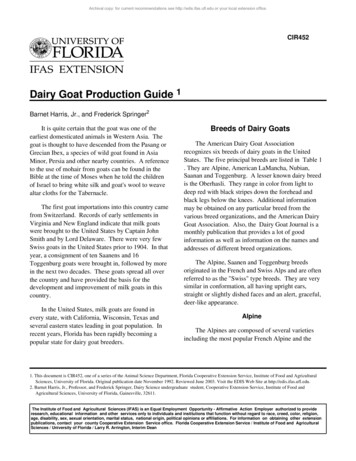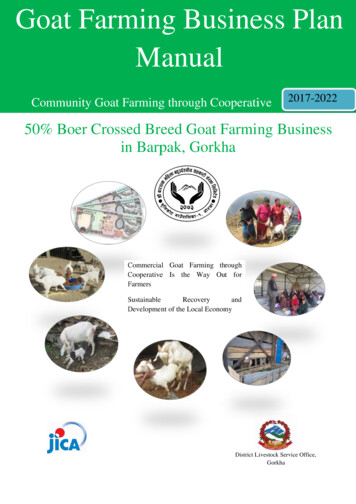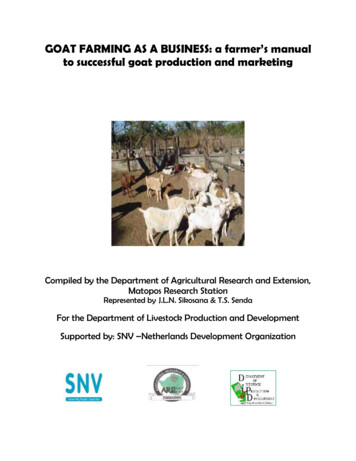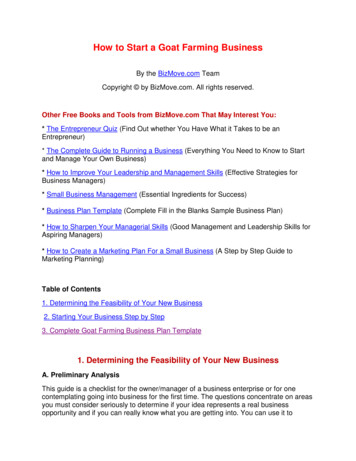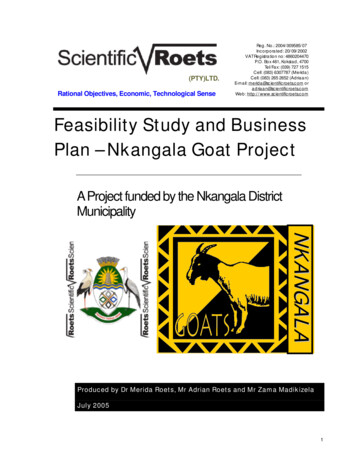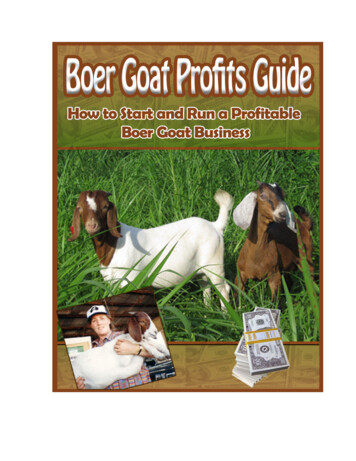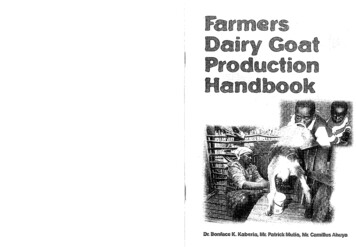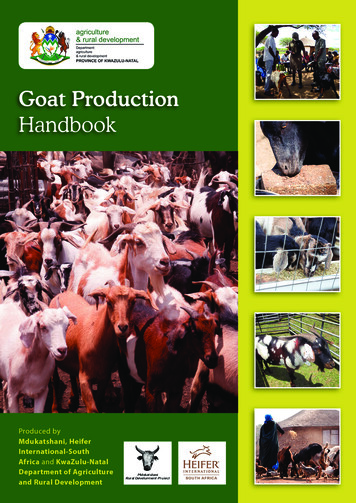
Transcription
Goat Production Handbook2015Prepared by:Mdukatshani, Heifer International-South Africa and KwaZuluNatal Department of Agriculture and Rural DevelopmentContributors:Rauri Alcock, Robert de Neef, Hannes de Villiers, TrevorDugmore, Francois du Toit, Marisia Geraci, Sibongiseni Gcumisa,Sibusiso Gumede, Jessica Kincaid-Smith, Manqhai Kraai, BrigidLetty, Joanne Mann, Gugu Mbatha, Dumisani Mtshali, DerrynNash, Nomfuzo Mkhize, Derryn Nash, Zandile Ndlovu, KeithPerrett, Alan Rowe, Janet Taylor, Thati Tladi, Erika van ZylThis book has made use of material contained in a deliverablesubmitted under the Goat Commercialisation Pilot Projectto KZN Department of Economic Development, Tourism andEnvironmental Affairs (DEDTEA) by the Institute of NaturalResources NPC in 2010. The contribution of DEDTEA is herebyacknowledged.Illustrations: Stefan de VosDesign and layout: Tangerine Design
Goat ProductionHandbookProduced byMdukatshani, Heifer International-South Africa and KwaZulu-Natal Departmentof Agriculture and Rural Development
2Goat Production Handbook
ContentsPurpose of this book .6PART 1: BASICS OF KEEPING GOATS .71. An introduction to goats .81.1 Different goat breeds. 81.2 Basic information for indigenous goats. 91.3 Handling your goats. 91.4 Flock identification .102. Keeping your animal healthy . 112.1 Why keep animals healthy?.112.2 Why is flock health important?.122.3 What keeps animals healthy?.132.4 Why is food important?.142.5 What is the importance of good hygiene practices?.142.6 Vaccination (preventative health care).143. Common diseases and conditions . 153.1 Heartwater (Umqhaqhazelo emazinyaneni).153.2 Abscesses (Amathumba).163.3 “Malkop” or “Draai Siekte” (Tapeworm cyst in the brain causing brain damage).163.4 Scours or diarrhoea.173.5 Mange.173.6 Coccidiosis.183.7 Orf.193.8 Foot problems.193.9 Bloat.213.10 Mastitis (Ukufa kwemibele).213.11 Abortion.223.12 Tetanus.233.13 Infectious pneumonia (Pasteurellosis).233.14 Pulpy Kidney (Enterotoxaemia).243.15 Bluetongue.253.16 Black Quarter/Quarter Evil (Umkhonywana) .263.17 Uncommon diseases.27Goat Production Handbook3
4. Internal and external parasites. 294.1 Internal parasites.29Checking for signs of anaemia.324.2 External parasites.334.3 Poisonous plants.354.4 Deaths due to eating plastic.375. Basic equipment and vet kit essentials. 385.1 Key equipment.385.2 Consumable medicines and equipment.395.3 Storage of medication, expiry dates and withdrawal periods.406. Treating your animals correctly. 416.1 Method of giving medication.416.2 Weighing your goat.416.3 Giving the correct dosage.416.4 Taking your goat’s temperature.426.5 Giving injections.436.6 Trimming hooves.44PART 2: GOAT COMMERCIALISATION . 457. General management . 467.1 Condition scoring.467.2 Ear tagging .477.3 Record keeping.487.4 Checking age of goat.487.5 Treatment calendar (including vaccination).498. Housing and handling facilities . 508.1 Shelter.508.2 Equipment for feed and water provision.518.3 Handling facilities .529. Nutrition and feeding . 539.1 Basics of nutrition and feeding.539.2 Supplementary feeding of goats .5610. Reproduction and kidding . 6110.1 Breeding season.6110.2 Ram management.614Goat Production Handbook
10.3 Ewe management.6211. Kid rearing . 6411.1 Interventions to reduce kid mortalities.6411.2 Castration.6411.3 Rearing orphans.6511.4 Creep feeding kids.6611.5 Weaning.68PART 3: MARKETING AND VALUE ADDING . 6912. Economics of keeping goats . 7012.1 Different production systems .7012.2 Herd composition – How to make your herd more commercially viable.7112.3 Understanding the costs, income and profitability of your business.7113. Value adding and marketing . 7213.1 Selling live goats.7213.2 Sale of skins.7614. Transporting goats . 7715. How to use veld . 7815.1 The principles of veld management.7815.2 What does this mean for the way you manage your goats?.8016. References . 81PART 4: RESOURCES . 83Sources of information.84The need to know your goat’s weight.85Improved breeding system.86Blocking against heartwater.87Community Animal Health Workers.87Alternative design for a goat shed.88Record keeping.90Determining the profitability of the business.93Goat Production Handbook5
Purpose of this bookThe aim of this book is to assist owners of indigenous goats with extensive farming systems. Itlooks at ways to improve the productivity of their flocks. It is designed to be shared with farmersin a way that allows them to understand how to find their way through the book and how to findthe information that they need. It is best if the book is part of a capacity building programmebeing implemented by extension officers and field workers.There are further training materials to support training farmers on this book. They are availableat www.mdukatshani.com or www.heifer.org.za . These are training modules linked to sections inthe book and are in downloadable .pdf for printing or a downloadable PowerPoint presentation.The book is divided into four parts.Part 1– Basics of Keeping Goats: This section covers the basics of keeping goats, includinghandling them properly, keeping them healthy, identifying common diseases and otherhealth-related problems, treating sick goats properly (including basic equipment and medicinesyou should have on hand), and dealing with internal and external parasites.Part 2 – Goat Commercialisation: The next section is more focused on commercialising goatproduction. It is for goat owners who want to invest more time and resources in managing theirgoats. This section covers some general management practices (including record keeping),housing and handling facilities, flock identification, nutrition and feeding, reproduction and kidrearing.Part 3 – Marketing and Value Adding: The final section is aimed at goat owners whose mainaim is to market their goats. It looks at the economics of goat production, opportunities formarketing and value-adding, proper transportation of goats and veld management.Part 4 – Resources is a section that contains additional materials that you may find useful. Thisincludes record sheet templates, the information to make your own goat weight belts, andsources of information (books and websites), as well as detailed economic analyses of varioussize herds.This book is not for sale but is distributed as part of a training program. It is available as a freedownload in Zulu or English, from the two websites listed above.6Goat Production Handbook
PART 1Basics of KeepingGoatsGoat Production Handbook7
1. An introduction to goats1.1 Different goat breedsGoat breeds can be divided into three categories:1. Indigenous breeds which have been naturally selected for adaptability to harsh environments and which are generally used for meat production, but are also important for culturalpurposes.Figure 1.1 Indigenous goats in Msinga.2. Meat breeds which have been specifically bred for meat producing characteristics. Suchbreeds available in South Africa include Boer Goats, Savanna Goats and Kalahari Red Goats.It is generally accepted that they are more susceptible to disease than non-improved goats.Figure 1.2 Meat goat breeds in South Africa (Boer1, Savanna2 and Kalahari Red Goats3).1 www.kandklivestock.com/html/boer goats.html2 NAH.JPG3 Kalahari%20red/Kalaharired3.jpg8Goat Production Handbook
3. Dairy breeds which are all imported breeds and include mainly Saanen goats and Toggenburg goats. These are breeds that have been selected for milk production and are usedfor the production of milk and processed milk products such as cheese and yoghurt. It isgenerally accepted thatthese breeds are verysusceptible to diseasesand parasites. Figure 1.3 Common dairygoat breeds in South Africa(Saanen4 and Toggenburg5).1.2 Basic information for indigenous goatsProduction norms for different goats are fairly variable. This user guide will focus on indigenoustype goats and provide some information that can guide a goat farmer and allow him or her toassess the herd’s performance.yy Length of gestation period (pregnancy) 150 days (approximately 5 months)yy Birth weight 2.5 kgyy Weaning weight (weight when kid stops suckling) 12-15 kgyy Mature mass of female 35-40 kgyy Mature mass of rams 45-50 kgyy Breeding age for young ewes 9 monthsyy Main kidding seasons (April–June) or (September–December)yy Ram/ewe ratio 1 ram to 20 ewes (5 rams for every 100 ewes)yy Lifespan (10-12 years).1.3 Handling your goatsThe main thing to consider when handling goats6 is to keep them calm and prevent injuries,both of which will improve the productivity of the goats. Smallish pens and handling facilitiesallow for easier handling of the goats than trying to work within a camp.When handling goats, you need to understand their natural behaviour. For example:yy They prefer to move towards light than darkyy They prefer to stay with the herd than be separated, which can distress them4 http://www.teara.govt.nz/files/p16593pc.jpg5 http://www.dpi.nsw.gov.au/ data/assets/image/0010/178669/toggenburg-doe.jpg6 Schoenian, S. Efficient handling of meat goats Goat Production Handbook9
yy They like to follow the leaderyy They tend to move in a circle in the penaround the handleryy They are easily distracted by noiseyy They can become aggressive towardseach other when confined and stressedyy They prefer to move in family groupsyy They can jump over gates and findescape opportunitiesyy Standing behind the animal’s shoulderwill generally encourage it to moveforward. If you move quickly down nextto the race in the opposite directionto the goats, they will generally moveforwards up the raceyy Keep the goat upright when trimminghoovesyy Try to get the goats used to beinghandled so that they are less stressedyy When holding a goat by the horns, holdthe base of the horns and not the tipsyy Work calmly and quietly with your goats.Figure 1.4 Catching a goat correctly (above the hock) so asto not damage the leg (top picture) and holding it securely(below).1.4 Flock identificationObtaining an identification mark (KZN diptank mark or personal mark)According to the Animal Identification Act, Act No.6 of 2002, all livestock must be marked oridentified. While cattle are generally branded, goats are tattooed in the ear with the owner’sidentification mark.Each livestock owner must have their own identification mark. This is obtained by applying tothe National Department of Agriculture in Pretoria. An identification mark certificate is thenissued and it carries a unique identification code for each livestock owner. This is the same markthat will also be used when tattooing your goats.Diptanks can have an identification mark registered by the Department of Agriculture which canbe used by all members belonging to the particular diptank, however problems of confirmingownership of livestock cannot be excluded. Therefore, the safest and legal way of identifyinglivestock is for each farmer to have their own identification mark.10Goat Production Handbook
TattooingTattooing is a way of identifying goats. Tattooing equipment: includes tattoo pliers, tattoo characters (lettersand numbers) for the pliers and tattoo ink. These can beordered and purchased through the local farmer co-operative.Method of tattooing:1. Clean the inside of the ear (the ears have dirt and oil onit that will prevent the ink from filling the holes madeby the tattoo pliers)2. Apply the tattoo ink on the area to be tattooed3. Ensure that the sequence of the tattooing characters iscorrect according to the certificate of registration4. Press the tattooing pliers until holes appear on the skinand then release5. Rub the ink into the holes6. The excess ink can be cleaned. The characters shouldbe easily readable as black dotes in the ear.Figure 1.5 Equipment for ear tattooing and application of the tattoo toan ear.72. Keeping your animal healthy2.1 Why keep animals healthy?A healthy animal is more able to resist diseases and can recover more easily when it does get sick.A sick animal costs a farmer money and time. A farmer with a sick animal has to buy medicines,syringes and needles. It is therefore better for a farmer if animals stay healthy and do not get sick.Treatment is also more successful if it is given early, before the animal is so sick that the medicinecannot help it. This means that a farmer must be able to tell very quickly if he or she has a sickanimal, what sickness it has and what he or she can do about it.7 0.gifGoat Production Handbook11
Goats can be kept healthy by:yy Ensuring that they have access to enough feed of the correct qualityyy Ensuring they have access to clean wateryy Following a vaccination programme against common diseasesyy Keeping internal and external parasites under controlyy Keeping sick goats separate so that disease does not spread to healthy goatsyy Making sure that any goats introduced to the flock are disease-freeyy Sheltering goats from adverse weather.If a goat does get sick it needs to be treated. More importantly, it is essential to keep a recordof goats that you treat because if a particular animal gets sick often, it should be culled as it is aweak individual and is not only costing you money but is also passing on its genes to the nextgeneration.How do I know if my goat is sick? If the goat is sick:yy It will appear dull and listlessyy It may have obvious symptoms of sickness such as coughing or diarrhoeayy It may not follow the rest of the flock when they go out to feedyy It may have an abnormal temperature – either too high or too low.2.2 Why is flock health important?One sick animal can sometimes contaminate other healthy animals and cause them to get sicktoo. This can also result in the sick animal getting re-infected after it has recovered.Sometimes when a farmer has many sick animals, or a neighbour has sick animals, it meansthat the amount of disease in the area is very high. It is very difficult to keep individual animalshealthy when there is a lot of disease around. Farmers who are aware of common diseases intheir area need to think strategically about how to combat these diseases as a community ratherthan trying to just keep their own animals healthy.This is also true of parasites that cause diseases, like ticks and worms. If some animals have a lotof ticks or worms, then it is difficult to stop the ticks and worms spreading to all the animals ina herd.So before we consider how to treat diseases, it is best to think about how to recognise healthyanimals and how to keep them healthy.12Goat Production Handbook
2.3 What keeps animals healthy?The immune system keeps the animal healthy. All animals and people have immune systems.The job of the immune system is to fight germs that invade the animal and could cause it to getsick. The immune system is like the animal’s own army, ready at all times to fight invaders thatput the animal’s life at risk.The immune system is found everywhere in the animal’s body. It is made up of millions of littlecells that are too small for people to see with their eyes. When germs enter the animal’s body,these immune cells come from all over to attack the germs. If the cells win the battle, the animalstays healthy. If they lose the battle, the animal may get sick and need treatment. The cells areproduced in the bone marrow and then spread around the body in the blood.The immune system can recognise diseases if it has fought these diseases before. With somediseases, like contagious abortion (CA), this recognition lasts the animal’s whole life. With otherdiseases, however, the immune system can recognise the disease when it is present often butstops being able to recognise it when the animal hasn’t had it for a long time. Common diseasesof this kind are those that ticks cause. This is one reason why animals often get sick in earlysummer when there are a lot of ticks after there have been so few in winter. Once the animal’simmune system is used to the ticks again, then the animal can often fight
the book and are in downloadable .pdf for printing or a downloadable PowerPoint presentation. The book is divided into four parts. Part 1– Basics of Keeping Goats: This section covers the basics of keeping goats, including handling them properly, ke


